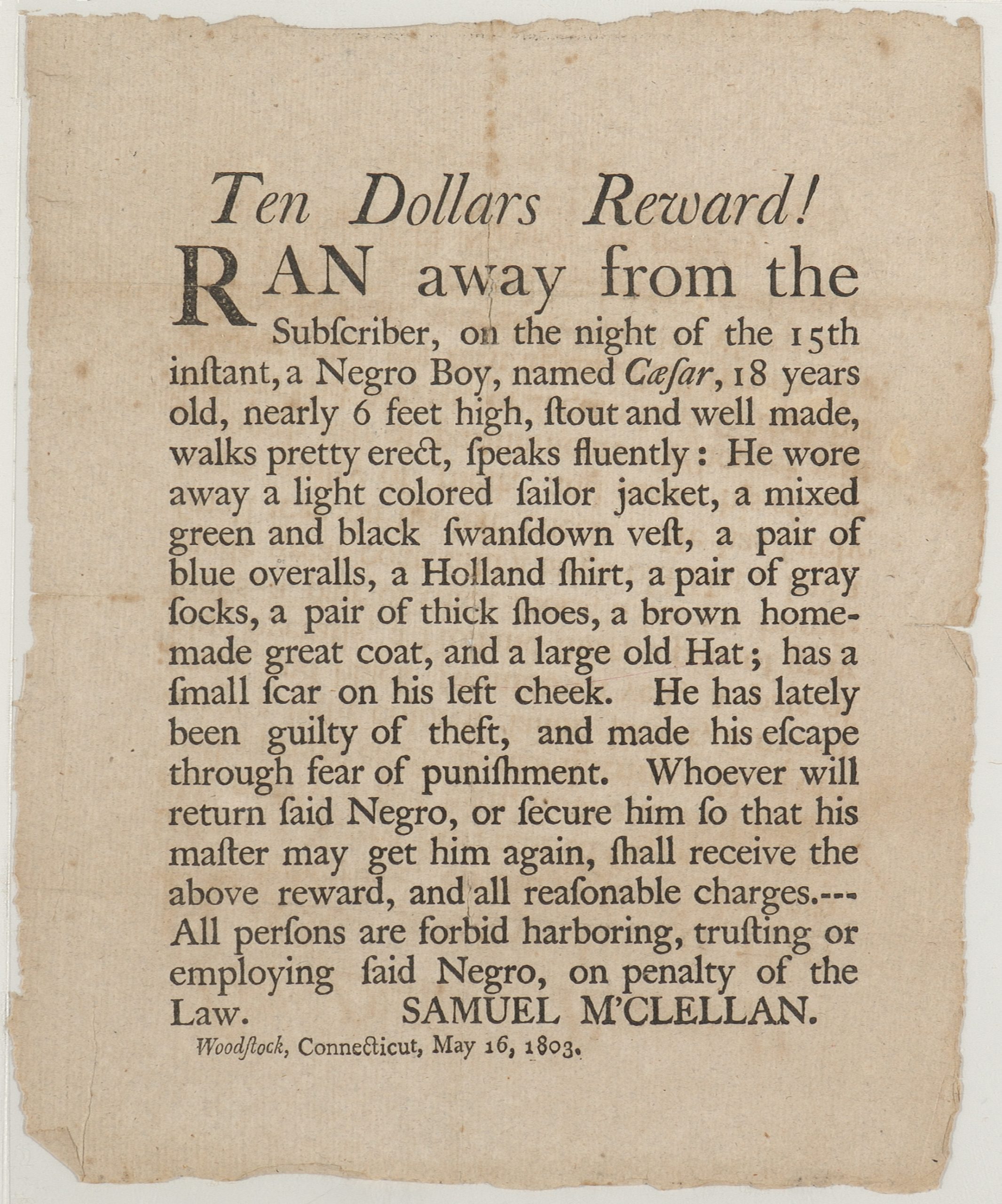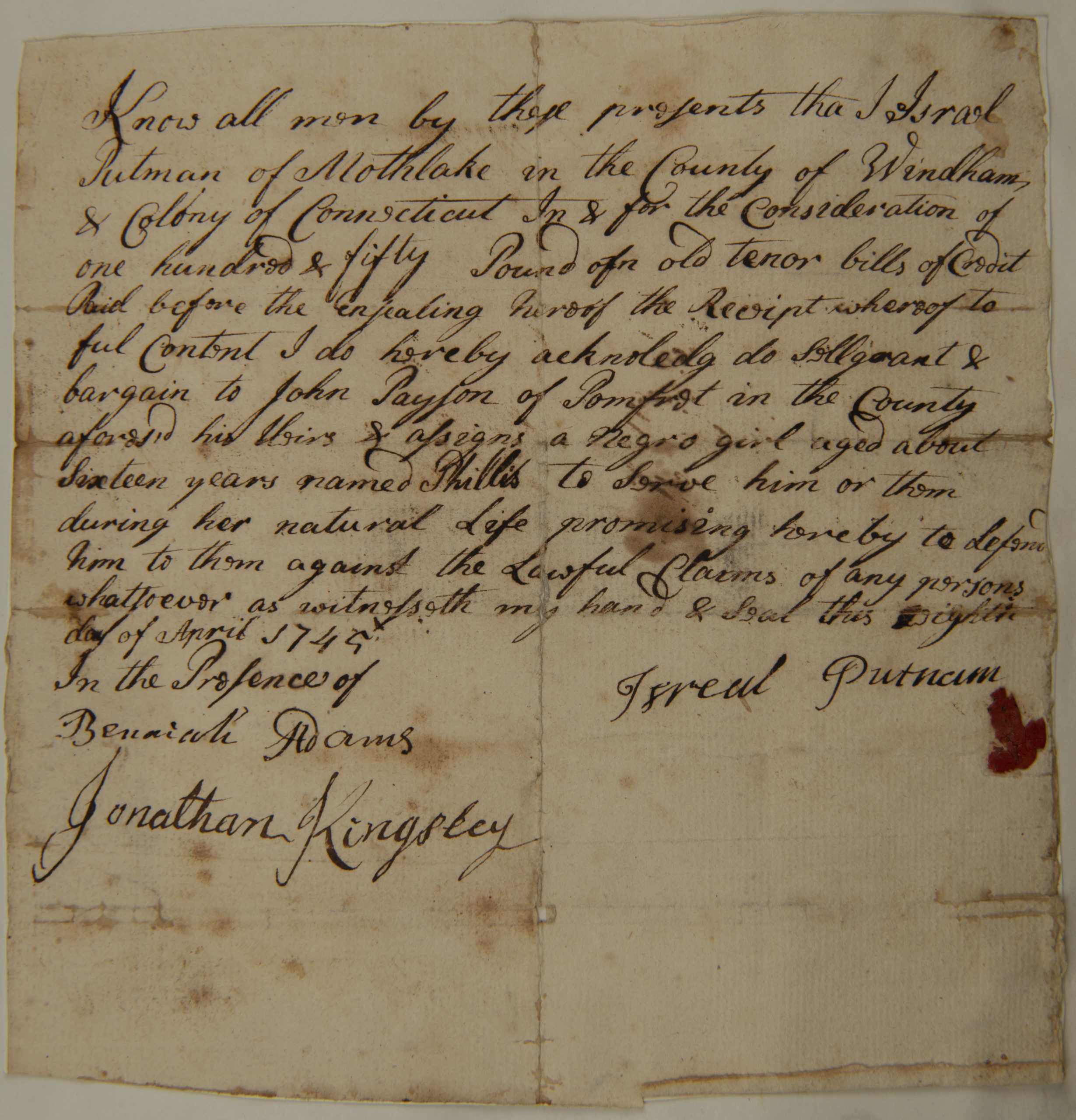Melissa Zablonski
Putnam High School
TEACHER'S SNAPSHOT
Subjects:
African Americans, Colonial History, Law, Slavery & Abolition
Course Topics/Big Ideas:
Democratic Principles and the Rule of Law, Role of Connecticut in U.S. History, The Struggle for Freedom, Equality, and Social Justice
Town:
Statewide
Grade:
Grade 8, High School
Lesson Plan Notes
When presented with the term “slave states,” most associate a list of states from the South. However, the New England colonies, then states, were also hotbeds of slavery from their founding until their emancipation laws went into effect. Connecticut was the last state in New England to abolish slavery, in 1848. In this lesson, students will explore how Connecticut was, as described by the Hartford Courant in 2014, “complicit” in our country’s brutal history of slavery. By examining Connecticut’s slave statutes and two historical slave advertisements, students will trace Connecticut’s identity as a slave state.
ESSENTIAL QUESTION
SUPPORTING QUESTIONS
- What role did slavery play in building Connecticut?
- How did Connecticut slave statutes change over time?
- Why should Connecticut’s history of slavery be told?
ACTIVITY
Introduction
- Teacher will project the 1803 notice. The class will discuss: What is the purpose of this document? Where would it have been posted? What kinds of information does it include? Who are the people mentioned? Where had this enslaved person escaped from? (Note the specific town and state.) What do you think or wonder after looking at this document?
- Teacher will then project Israel Putnam’s bill of sale for a teen-aged girl. The class will discuss: What is the purpose of this document? Where is this taking place? Why is that important?
- Students should note that both documents come from Connecticut, as opposed to a southern state. Does this challenge any preconceptions they had about slavery in the United States?
Activity #1
- Students will be asked the question: How did Connecticut develop as a slave state?
- Students will view the Connecticut Slave Statutes identified in the graphic organizer and complete the organizer. In their own words, students will write a “translation” of what each statute meant regarding slavery in Connecticut.
- After completing the organizer, students will answer the question: How did Connecticut develop as a slave state? They will create a claim that is supported with evidence and reasoning based on the slave statutes.
Activity #2
- Students will read the Hartford Courant article, “The State that Slavery Built: An Introduction.”
- Students will engage in a Think-Pair-Share to answer the following questions: How did Connecticut benefit from slavery? How does this article help explain the evolution of slave statutes in Connecticut? Why is this part of Connecticut history often ignored? Resources on effective use of the “Think-Pair-Share” strategy can be found at Facing History & Ourselves.
OPPORTUNITIES FOR ASSESSMENT
- Students will research how their town or county contributed to Connecticut’s complicity in slavery. Using libraries, the Witness Stones Project, internet searches, or other means, students will identify the ways in which slavery was present in their communities. Students will choose a medium through which to disseminate this information, such as an article, video, placard, or addition to the Witness Stones Project database.
- Students will write a textbook entry or journal article that provides an accurate account of Connecticut’s history with slavery. The textbook entry or article should explain the development of Connecticut’s slave statutes and the ways in which Connecticut benefited from slavery. Students should cite specific historical sources or evidence.
RESOURCE TOOL KIT

“Ten Dollars Reward!” Woodstock, Connecticut, 1803. Connecticut Museum of Culture and History.

Putnam, Israel. Bill of sale for a teenage girl named Phillis, 8 April 1745. Connecticut Museum of Culture and History.

“Text from Statutes.” Witness to History: Slavery in Guilford.
“The state that slavery built: An introduction.” Editors. Hartford Courant. (2002, September 29).
ADDITIONAL RESOURCES
Places to GO
Connecticut Museum of Culture and History, Hartford
Sites on the Connecticut Freedom Trail
Things To DO
Visit the exhibit: Here All Along: African Americans in Northeastern Connecticut Before the Great Migration at the Windham Textile and History Museum.
Websites to VISIT
Connecticut Museum of Culture and History
Gilder Lehrman Center for the Study of Slavery, Resistance, and Abolition at the Yale MacMillan Center
Topic: Slavery and Abolition, ConnecticutHistory.org
Topic: Slavery in Connecticut, Connecticut Explored
Articles to READ
Groark, V. (2002). “Slave policies.” The New York Times.
Cohen, J. (2022). “New report on Transatlantic Slave Trade links Connecticut’s past to present.” Connecticut Public Radio.
“Gradual Emancipation Reflected the Struggle of Some to Envision Black Freedom” by Peter P. Hinks. ConnecticutHistory.org.



